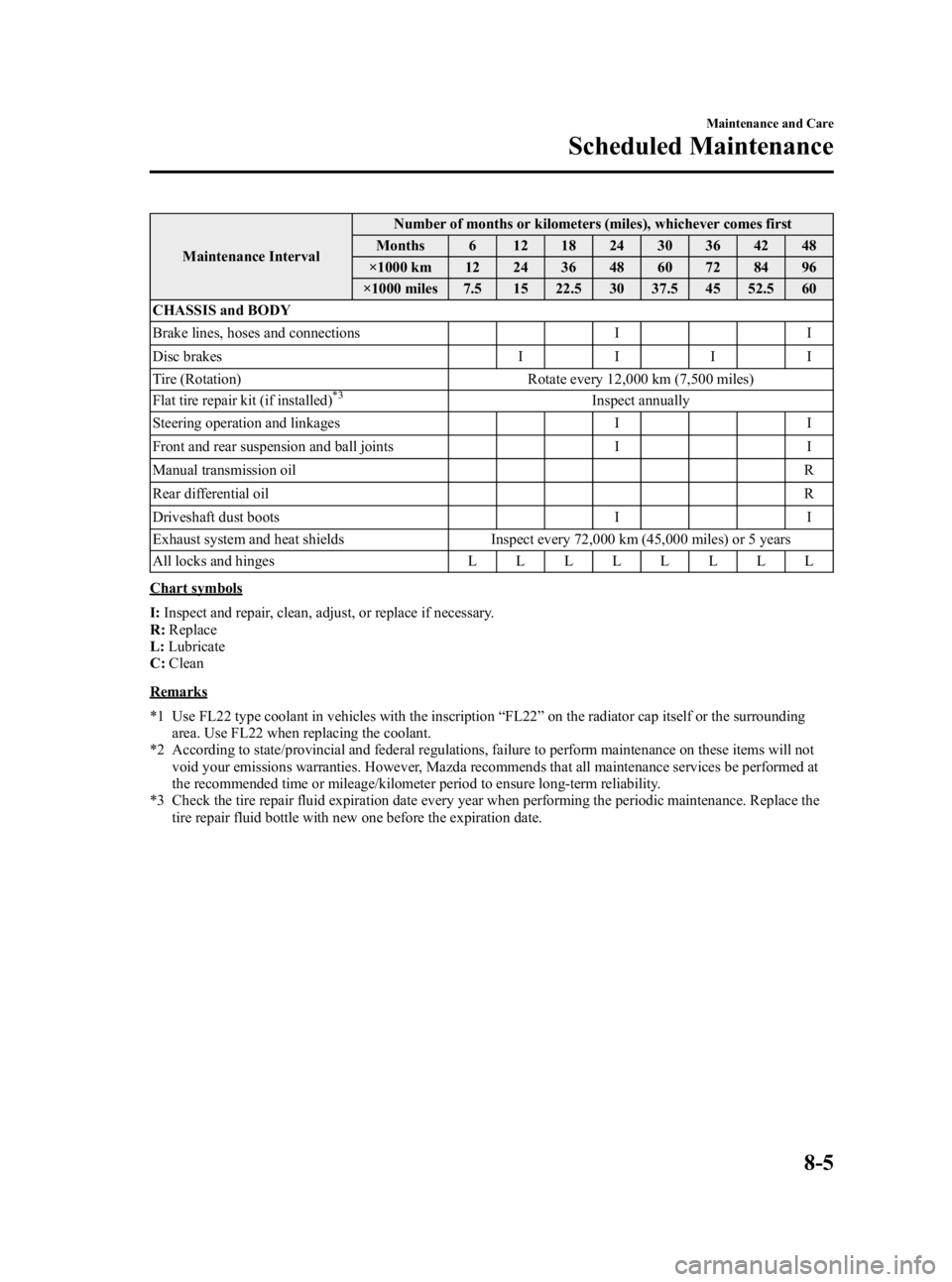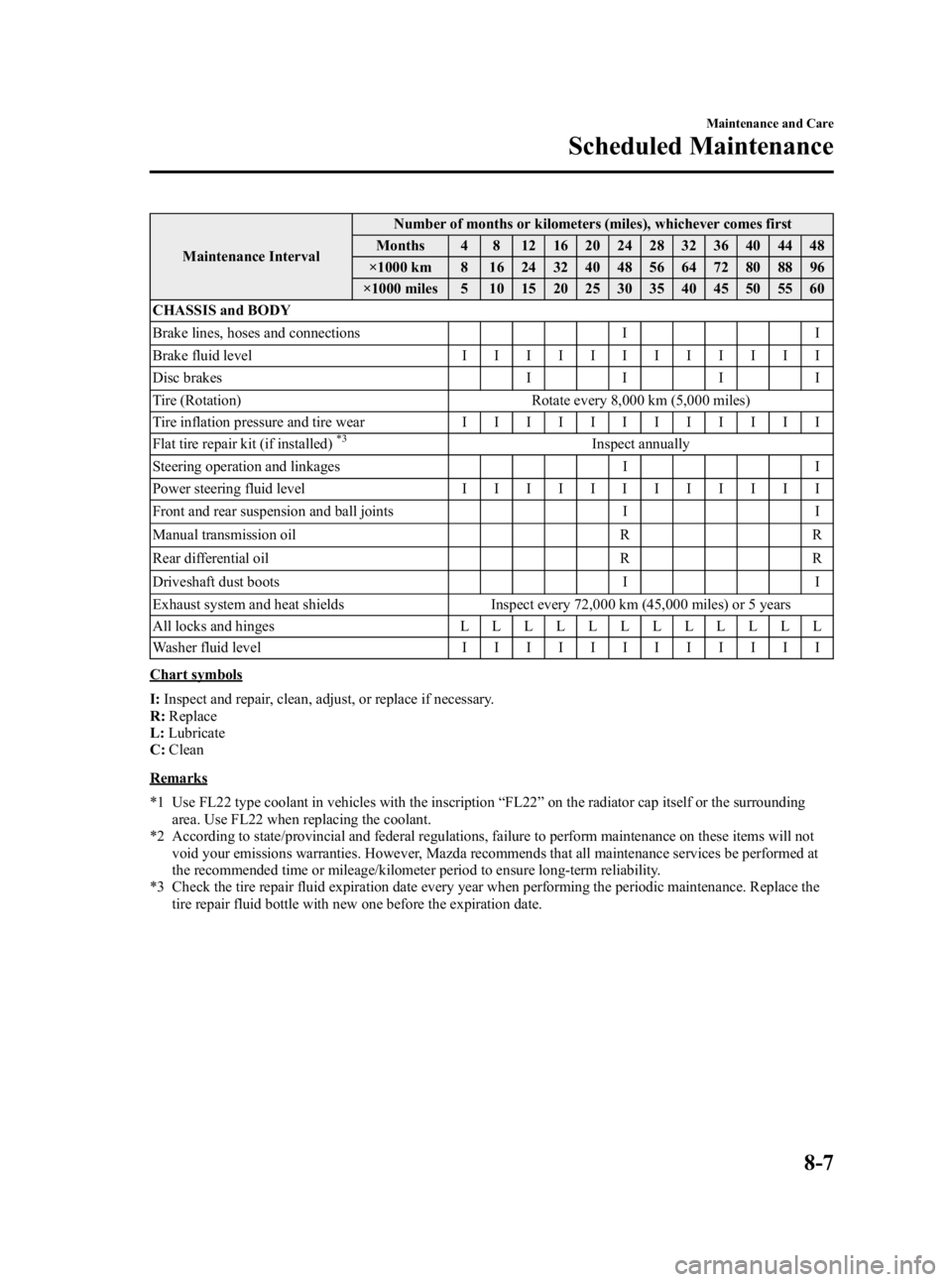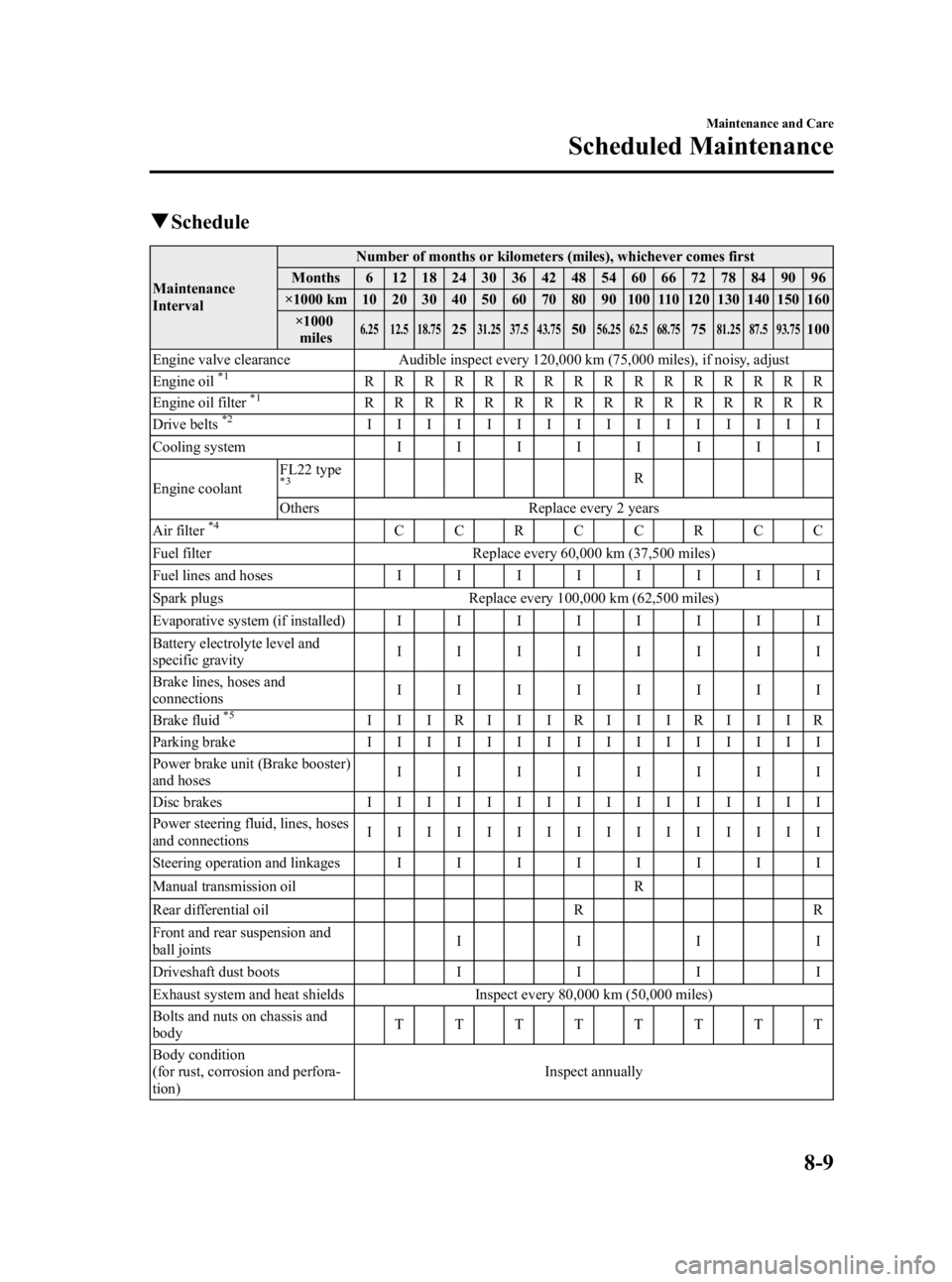Manual transmission MAZDA MODEL MX-5 MIATA 2006 User Guide
[x] Cancel search | Manufacturer: MAZDA, Model Year: 2006, Model line: MODEL MX-5 MIATA, Model: MAZDA MODEL MX-5 MIATA 2006Pages: 378, PDF Size: 4.01 MB
Page 152 of 378

Black plate (152,1)
NOTE
lWhen driving slowly, the gears may
not shift up depending on vehicle
speed.
lIn manual shift mode, gears do not
shift up automatically. Don't run the
engine with the tachometer needle in
the RED ZONE. If the tachometer
needle enters the RED ZONE, you
may feel engine-braking because the
fuel delivery will be stopped to
protect the engine. However, this
does not indicate an abnormality.
lWhen depressing the accelerator
fully, the transmission will shift to a
lower gear, depending on vehicle
speed (Except M2→M1).
Manually Shifting down
(M6 →M5 →M4 →M3 →M2 →M1)
To shift down to a lower gear, tap the shift
lever forward (
) once.
To shift down to a lower gear with the
steering shift switches, press either of the
DOWN switches away from you once
with your thumb.
DOWN switches
WARNING
Sudden Engine-Braking:
Shifting down while driving on wet,
snowy, or frozen roads, or while
driving at high speeds causes sudden
engine braking, which is dangerous.
The sudden change in tire speed could
cause the tires to skid. This could lead
to loss of vehicle control and an
accident. Do not use sudden engine
braking on slippery road surfaces or at
high speeds.
Hand Position When Using Steering
Shift Switches:
Putting your hands inside the rim of
the steering wheel when using the
steering shift switches is dangerous. If
the driver air bag were to deploy in a
collision, your hands could be
impacted causing injury. Keep your
hands on the steering wheel rim when
using fingers or thumbs on the
steering shift switches.
5-16
Driving Your Mazda
Starting and Driving
MX-5_8U35-EA-05F_Edition4 Page152
Thursday, October 6 2005 11:3 AM
Form No.8U35-EA-05F
Page 158 of 378

Black plate (158,1)
qTo Resume Cruising Speed at
More Than 30 km/h (19 mph)
If some other method besides the ON/
OFF switch was used to cancel cruising
speed and the system is still activated, the
most recent set speed will automatically
resume when the cruise control switch
pulled up.
If vehicle speed is below 30 km/h (19
mph), increase the vehicle speed up to 30
km/h (19 mph) and pull up the cruise
control switch.
Cruise
control
switch
qTo Cancel
To turn off the system, use oneof these
methods:
lPress the ON/OFF switch.
lSlightly depress the brake pedal.
lDepress the clutch pedal (Manual
transmission only).
lPress the CANCEL button.
The system is off when the ignition is off.
NOTE
Cruise control will cancel at about 15
km/h (9 mph) below the preset speed or
below 30 km/h (19 mph).
5-22
Driving Your Mazda
Starting and Driving
MX-5_8U35-EA-05F_Edition4 Page158
Thursday, October 6 2005 11:3 AM
Form No.8U35-EA-05F
Page 246 of 378

Black plate (246,1)
NOTE
lThe tire sealant cannot be reused.
Purchase new tire sealant at an
Authorized Mazda Dealer.
lThe emergency flat tire repair kit
cannot be used in the following
cases.
Consult an Authorized Mazda
Dealer.
lThe period of effective use for the
tire sealant has expired. (The
period of effectiveness is
indicated on the bottle label.)
lThe tear or puncture exceeds
about 4 mm (0.16 in).
lThe damage has occurred to an
area of the tire other than the
tread.
lThe vehicle has been driven with
nearly no air remaining in the tire.
lThe tire has come off the wheel
rim.
lDamage to the wheel rim has
occurred.
lThe tire has two or more
punctures.
qUsing the IMS Emergency Flat
Tire Repair Kit
1. Park on a level surface off the right-of-
way and set the parking brake.
2. Put a vehicle with an automatic transmission in Park (P), a manual
transmission in Reverse (R) or 1, and
turn off the engine.
3. Turn on the hazard warning flasher. 4. Unload passengers and luggage, and
remove the emergency flat tire repair
kit.
5. Shake the tire sealant well.
CAUTION
If the bottle is shaken after the injection
hose is screwed on, tire sealant could
spray out from the injection hose. Tire
sealant contacting clothing or other
objects may be impossible to remove.
Shake the bottle before screwing on the
injection hose.
7-8
In Case of an Emergency
Flat Tire
MX-5_8U35-EA-05F_Edition4 Page246
Thursday, October 6 2005 11:5 AM
Form No.8U35-EA-05F
Page 252 of 378

Black plate (252,1)
NOTE
lMake sure the jack is well lubricated
before using it.
(With Tire Pressure Monitoring
System)
lBe sure to register the tire pressure
sensor ID signal code whenever tires
or wheels are changed (page 5-30).
1. Park on a level surface off the right-of- way and firmly set the parking brake.
2. Put a vehicle with an automatic transmission in Park (P), a manual
transmission in Reverse (R) or 1, and
turn off the engine.
3. Turn on the hazard warning flasher.
4. Have everyone get out of the vehicle and away from the vehicle and traffic.
5. Remove the jack, and tool (page 7-5).
6. Block the wheel diagonally opposite the tire to be changed. When blocking
a wheel, place a tire block both in front
and behind the tire.
NOTE
When blocking a tire, use rocks or
wood blocks of sufficient size to hold
the tire in place.
qRemoving a Tire
1. Loosen the lug nuts by turning them
counterclockwise one turn each, but
don't remove any until the tire has been
raised off the ground.
2. Place the jack under the jackingposition closest to the tire being
changed.
Jacking position
7-14
In Case of an Emergency
Flat Tire
MX-5_8U35-EA-05F_Edition4 Page252
Thursday, October 6 2005 11:5 AM
Form No.8U35-EA-05F
Page 257 of 378

Black plate (257,1)
Overheating
If the temperature gauge indicates
overheating, the vehicle loses power, or
you hear a loud knocking or pinging
noise, the engine is probably too hot.
WARNING
Electrical Fan and Engine
Inspection:
Working near the electrical cooling
fan when it is running is dangerous.
You could be hit by the fan and
seriously injured. Turn off the ignition
switch and make sure the fan is not
running before attempting to work
near the electrical cooling fan.
Cooling System Cap:
When the engine and radiator are hot,
scalding coolant and steam may shoot
out under pressure and cause serious
injury. Don't remove the cooling
system cap when the engine and
radiator are hot.
Steam from Overheated Engine:
Steam from an overheated engine is
dangerous. The escaping steam could
seriously burn you. Open the hood
ONLY after steam is no longer
escaping from the engine.
NOTE
Once the engine coolant exceeds a
preset temperature, an electrical cooling
fan turns on. It will continue running
for about 10 minutes after the ignition
switch is turned to off.
If the temperature gauge indicates
overheating:
1. Drive safely to the side of the road and park off the right-of-way.
2. Put a vehicle with an automatic transmission in park (P), a manual
transmission in neutral.
Apply the parking brake.
3. Turn off the air conditioner.
4. Check whether coolant or steam is escaping from under the hood or from
the engine compartment.
If steam is coming from the engine
compartment:
Don't go near the front of the vehicle.
Stop the engine.
Wait until the steam dissipates, then
open the hood and start the engine.
If neither coolant nor steam is
escaping:
Open the hood and idle the engine until
it cools.
CAUTION
If the cooling fan does not operate
while the engine is running, the engine
temperature will increase. Stop the
engine and call an Authorized Mazda
Dealer.
In Case of an Emergency
Overheating
7-19
MX-5_8U35-EA-05F_Edition4 Page257
Thursday, October 6 2005 11:5 AM
Form No.8U35-EA-05F
Page 264 of 378

Black plate (264,1)
NOTE
lBefore installing the battery cover,
make sure both of the cables
connecting the negative battery
terminal (right side of battery) are
connected with the cables routed
toward the right and back of the
battery as shown in the figure.
lVerify that the covers are securely
installed.
Push-Starting
WARNING
Towing a Vehicle to Start It:
Towing a vehicle to start it is
dangerous. The vehicle being towed
could surge forward when its engine
starts, causing the two vehicles to
collide. The occupants could be
injured. Never tow a vehicle to start it.
You can't start a vehicle with an automatic
transmission by pushing it.
CAUTION
Do not push-start a vehicle that has a
manual transmission. It can damage the
emission control system.
7-26
In Case of an Emergency
Emergency Starting
MX-5_8U35-EA-05F_Edition4 Page264
Thursday, October 6 2005 11:5 AM
Form No.8U35-EA-05F
Page 273 of 378

Black plate (273,1)
Maintenance IntervalNumber of months or kilometers (miles), whichever comes first
Months 6 12 18 24 30 36 42 48
×1000 km 12 24 36 48 60 72 84 96
×1000 miles 7.5 15 22.5 30 37.5 45 52.5 60
CHASSIS and BODY
Brake lines, hoses and connections I I
Disc brakes IIII
Tire (Rotation) Rotate every 12,000 km (7,500 miles)
Flat tire repair kit (if installed)
*3Inspect annually
Steering operation and linkages II
Front and rear suspension and ball joints II
Manual transmission oil R
Rear differential oil R
Driveshaft dust boots II
Exhaust system and heat shields Inspect every 72,000 km (45,000 miles) or 5 years
All locks and hinges LLLLLLLL
Chart symbols
I:Inspect and repair, clean, adjust, or replace if necessary.
R: Replace
L: Lubricate
C: Clean
Remarks
*1 Use FL22 type coolant in vehicles with the inscription “FL22 ”on the radiator cap itself or the surrounding
area. Use FL22 when replacing the coolant.
*2 According to state/provincial and federal regulations, failure to perform maintenance on these items will not
void your emissions warranties. However, Mazda recommends that all maintenance services be performed at
the recommended time or mileage/kilometer period to ensure long-term reliability.
*3 Check the tire repair fluid expiration date every year when performing the periodic maintenance. Replace the tire repair fluid bottle with new one before the expiration date.
Maintenance and Care
Scheduled Maintenance
8-5
MX-5_8U35-EA-05F_Edition4 Page273
Thursday, October 6 2005 11:5 AM
Form No.8U35-EA-05F
Page 275 of 378

Black plate (275,1)
Maintenance IntervalNumber of months or kilometers (miles), whichever comes first
Months 4 8 12 16 20 24 28 32 36 40 44 48
×1000 km 8 16 24 32 40 48 56 64 72 80 88 96
×1000 miles 5 10 15 20 25 30 35 40 45 50 55 60
CHASSIS and BODY
Brake lines, hoses and connections I I
Brake fluid level IIIIIIIIIIII
Disc brakes IIII
Tire (Rotation) Rotate every 8,000 km (5,000 miles)
Tire inflation pressure and tire wear IIIIIIIIIIII
Flat tire repair kit (if installed)
*3Inspect annually
Steering operation and linkages II
Power steering fluid level IIIIIIIIIIII
Front and rear suspension and ball joints II
Manual transmission oil RR
Rear differential oil RR
Driveshaft dust boots II
Exhaust system and heat shields Inspect every 72,000 km (45,000 miles) or 5 years
All locks and hinges LLLLLLLLLLLL
Washer fluid level IIIIIIIIIIII
Chart symbols
I:Inspect and repair, clean, adjust, or replace if necessary.
R: Replace
L: Lubricate
C: Clean
Remarks
*1 Use FL22 type coolant in vehicles with the inscription “FL22 ”on the radiator cap itself or the surrounding
area. Use FL22 when replacing the coolant.
*2 According to state/provincial and federal regulations, failure to perform maintenance on these items will not void your emissions warranties. However, Mazda recommends that all maintenance services be performed at
the recommended time or mileage/kilometer period to ensure long-term reliability.
*3 Check the tire repair fluid expiration date every year when performing the periodic maintenance. Replace the tire repair fluid bottle with new one before the expiration date.
Maintenance and Care
Scheduled Maintenance
8-7
MX-5_8U35-EA-05F_Edition4 Page275
Thursday, October 6 2005 11:5 AM
Form No.8U35-EA-05F
Page 277 of 378

Black plate (277,1)
qSchedule
Maintenance
Interval Number of months or kilometers (miles), whichever comes first
Months 6 12 18 24 30 36 42 48 54 60 66 72 78 84 90 96
×1000 km 10 20 30 40 50 60 70 80 90 100 110 120 130 140 150 160 ×1000miles
6.25 12.5 18.752531.25 37.5 43.755056.25 62.5 68.757581.25 87.5 93.75100
Engine valve clearance Audible inspect every 120,000 km (75,000 miles), if noisy, adjust
Engine oil
*1RRRRRRRRRRRRRRRR
Engine oil filter*1RRRRRRRRRRRRRRRR
Drive belts*2IIIIIIIIIIIIIIII
Cooling system IIIIIIII
Engine coolant FL22 type
*3R
Others Replace every 2 years
Air filter
*4CCRCCRCC
Fuel filter Replace every 60,000 km (37,500 miles)
Fuel lines and hoses IIIIIIII
Spark plugs Replace every 100,000 km (62,500 miles)
Evaporative system (if installed) IIIIIIII
Battery electrolyte level and
specific gravity IIIIIIII
Brake lines, hoses and
connections IIIIIIII
Brake fluid
*5IIIRIIIRIIIRIIIR
Parking brake IIIIIIIIIIIIIIII
Power brake unit (Brake booster)
and hoses IIIIIIII
Disc brakes IIIIIIIIIIIIIIII
Power steering fluid, lines, hoses
and connections IIIIIIIIIIIIIIII
Steering operation and linkages IIIIIIII
Manual transmission oil R
Rear differential oil R R
Front and rear suspension and
ball joints IIII
Driveshaft dust boots IIII
Exhaust system and heat shields Inspect every 80,000 km (50,000 miles)
Bolts and nuts on chassis and
body TTTTTTTT
Body condition
(for rust, corrosion and perfora-
tion) Inspect annually
Maintenance and Care
Scheduled Maintenance
8-9
MX-5_8U35-EA-05F_Edition4 Page277
Thursday, October 6 2005 11:5 AM
Form No.8U35-EA-05F
Page 282 of 378

Black plate (282,1)
Engine Compartment Overview
Engine oil dipstick
Engine oil filler cap
Brake fluid reservoir / Clutch
fluid reservoir (only for manual
transmission model)
Washer fluid reservoir Cooling system capBattery
Engine coolant reservoir Power steering fluid cap
Air filter Fuse block
8-14
Maintenance and Care
Owner Maintenance
MX-5_8U35-EA-05F_Edition4 Page282
Thursday, October 6 2005 11:5 AM
Form No.8U35-EA-05F